There’s not a great deal known about Chinese photographer Lu Guang in the West. A few facts gleaned from a couple of interviews, a sketchy bio saying where and when he went to school, a couple of passing references to groups who’ve hired him, a list of photography prizes he’s won – that’s about it.
We can make some assumptions and educated guesses about his life based on a general knowledge of history, and we can jigsaw those in with the few known facts. But most of what we actually know about the man comes from his work – from the photographs. And they tell us a lot.
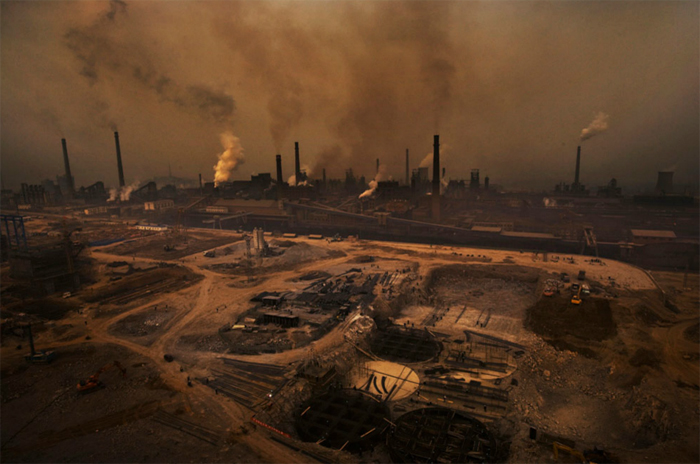
Here are the facts: Lu Guang was born in 1961 in the city of Yongkang in Zhejiang province on the coast of China. He became interested in photography at the age of nineteen, at a time when he was working in a silk factory in Yongkang. He later attended the Fine Arts Academy of Tsinghua University in Beijing, where he studied photography. He has since worked as a freelance photographer. Lu is best known for documenting terrible social and environmental situations that the Chinese government would prefer remain hidden.
That’s admirable in itself, to be sure. It’s all the more praiseworthy, however, when you remember that Lu grew up under the largest, and one of the most gloomy totalitarian governments in modern history. And when you consider that Asia, unlike the United States and Western Europe, has no real tradition of social documentary photography, the accomplishments of Lu Guang become absolutely astonishing.
When Lu was a boy growing up in Yongkang, China was almost entirely isolated from the world community. Mao Zedong’s policies at that time had turned the People’s Republic of China into a dull, grim world. Maoist orthodoxy required everybody to wear identical blue, green, or gray outfits. Ornamentation of any sort was considered decadent and deviant. Even the bicycles used for daily transportation were painted black. There was no such thing as self-expression; art was compelled to reflect the benefits of a Chinese socialist society.
Social documentary photography as we know it didn’t exist even as a concept. So how do we account for the career of Lu Guang?
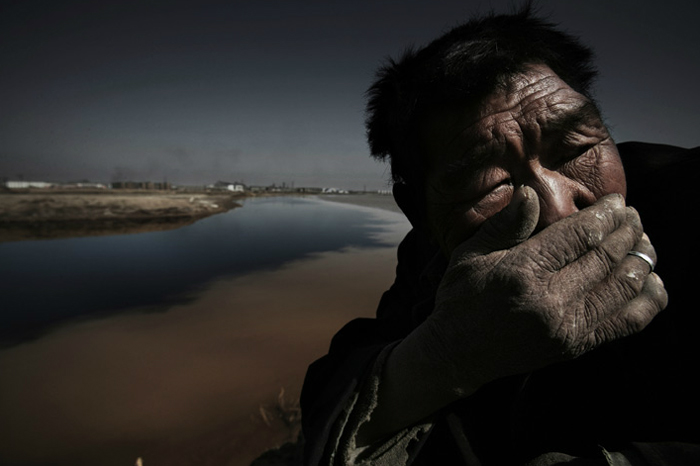
Lu was fifteen years old when Chairman Mao died. China’s new leaders implemented a socialist market economy, opening up the People’s Republic to foreign investment, to the global market, and to limited private competition. The shift in policy was a tremendous boost to the economy of the PRC. To greedy industrial manufacturers, the allure of unlimited cheap labor unregulated by standards for worker safety or environmental concerns was irresistible.
The change in economic policy and the influx of Western industry was necessarily accompanied by the introduction of ideas that violated Maoist orthodoxy. It required the loosening of some of the restrictions on personal freedom. Under Mao, it would have been unthinkable for a factory worker in Yongkang to move to Beijing and study photography. But in 1993, when he was in his early 30s, Lu Guang did just that.
We know that at some point during his studies, Lu was introduced to the photography of W. Eugene Smith. We know he eventually became familiar with Smith’s work on mercury pollution in Minimata, Japan in the 1970s. We also know Lu was passionate about the horrendous increase in pollution in China. Beyond that, we have to return to the realm of supposition.
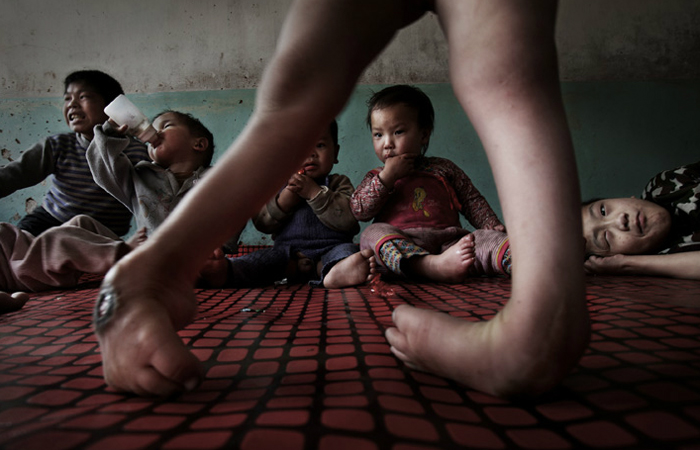
The coastal province of Zhejiang, where Lu was born, was once known as The Land of Fish and Rice. It’s a region predominantly covered by hills and mountains. Zhejiang’s primary natural resource was its deep water port. Such ports are necessary for manufacturers to ship their goods abroad. So it’s not surprising that China’s change in economic policy drew manufacturing plants to Zhejiang. The Land of Fish and Rice is now home to electro-mechanical industries, textile plants, chemical industries, and construction material factories. It’s become one of the richest provinces in China. It’s also one of the most polluted.
Again, with our limited facts, we have to rely on logical suppositions. Having grown up in Zhejiang, having worked in a silk factory, we can suppose Lu had witnessed the effects of global industrialization on people he knew. Having seen the photography of Eugene Smith, we can assume Lu grasped the potential of the medium to draw attention to the plight of people suffering from the effects of pollution. All we know for certain, though, is that after finishing his studies, Lu determinedly turned his attention and his lens on the working poor, on the marginalized populations of China, and on the unchecked havoc wrought by industrial pollution.
Using the money he earned from commercial photography, Lu began to travel around China and photographing the lives of the people he met. He photographed gold miners and coal miners, railway workers, HIV patients, the fishermen and their families who lived and worked on the increasingly polluted rivers. He documented a woman who took in babies who’d been born with severe birth defects and abandoned by their parents. He photographed shepherds who couldn’t stand the stink of the polluted rivers their flocks depended on for water. Lu gained international attention in 2003 when his photo series on peasants who’d become infected with HIV after selling their blood was awarded the first prize in the World Press Photo competition.
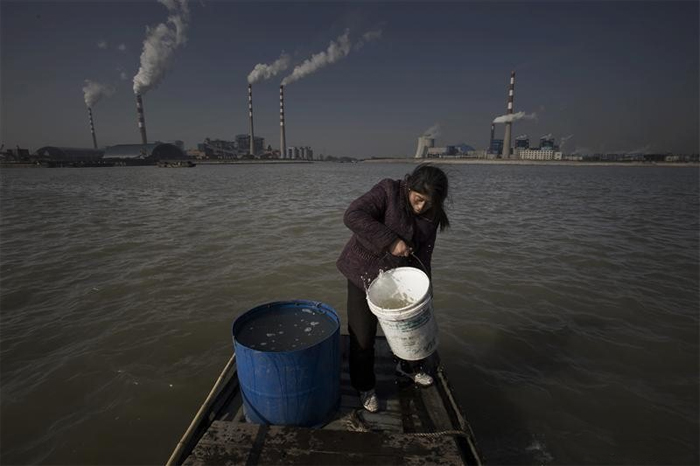
“I never think of winning an award when I take pictures,” Lu told an interviewer. “Recording is my priority. And of course, I want to solve problems. When I took these pictures, I told the local residents the reason why I took photos of them was that I wanted to help them solve the problems.”
He wants to help them solve the problems, but Lu is aware there’s little or nothing he can do to salvage the lives of the people he’s photographing. His work may benefit their children, or their grandchildren – but the current generation is already lost. For example, Lu documented the lives of families who’ve traditionally made their living fishing in Yanglin Harbor. Nearby factories now routinely pump sewage and unfiltered chemical waste water into the river feeding the harbor, even though it’s nominally illegal. The pollution kills many of the fish. The surviving fish feed off plants and small creatures tainted by the chemicals, becoming tainted themselves. The fishermen sell those fish, often to the low-wage workers employed by factories dumping waste into the harbor. The fishermen and their families eat the most tainted fish – the ones customers won’t buy. The families draw their cooking and drinking water from the harbor because purified water is too expensive. Nearby farmers rely on the river water to irrigate their fields; the chemical waste contaminates their crops. Cancer rates among children and the rate of birth defects have skyrocketed among factory workers, farmers, and fishermen in the region.
This generation is already lost. So too, perhaps, is the next.
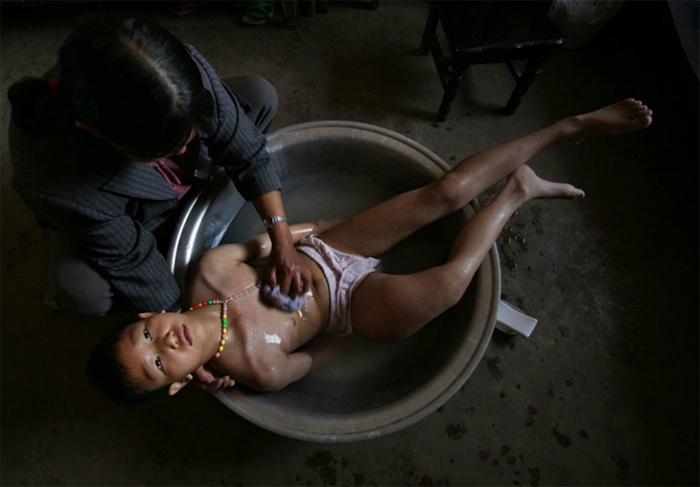
In 2009 Lu Guang’s Pollution in China series (from which most of the photographs here were drawn) was awarded the W. Eugene Smith Grant in Humanistic Photography. This is a grant given by the Smith Memorial Fund to photographers “who have demonstrated a deep commitment to documenting the human condition in the formidable tradition of compassionate dedication that W. Eugene Smith exhibited.”
That perfectly describes Lu, who was so inspired by Smith’s work early in his career. It’s impossible to look at the photograph of eleven year old Xu Li (above) without being reminded of Smith’s astonishing 1972 portrait of Tomoko Uemura in Her Bath. The resemblance of Lu’s photograph to Smith’s is undeniable, but perhaps the aspect of his life that most resembles Smith’s is his passion for honesty and his dedication to the people he photographs.
Winning an international photography prize like the Smith Grant is a grand thing, no mistake. Lu noted two ways in which winning the prize was important to him. “One, it recognized my work in the past years. Two, this set of photos will attract more people’s attention worldwide.”
Lu was being modest, though. He’s not just a photographer; he’s a humanitarian and a philanthropist in his own humble way. The Smith Grant included a cash prize of US$30,000. He used the money to fund his own work, to be sure, but he’s also given about half of that amount to help the people he photographs. “I myself don’t have much money,” he told an interviewer, “but I try my best to help them get on easier with life.” In another interview Lu said, “You cannot just be a cold-hearted photographer. I hope my camera will get more people to understand their plight and help them to some extent, but I myself should be the first one to help them with all my efforts.”
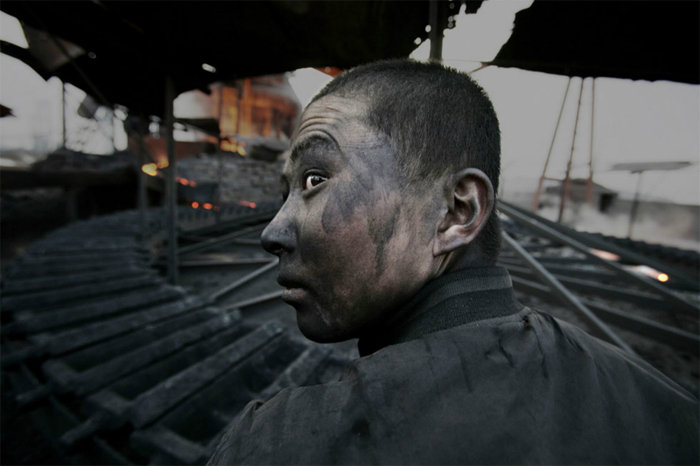
“Photography is hard work,” Lu has stated. He must despair at times. How could he not despair, seeing what he’s seen and knowing what he knows?
“I know that whenever I publish pictures, the related governments or organizations will go to investigate the issue and stop the pollution. However, after a while, the pollution comes back again.”
And there it is. Local Chinese governments want and need the financial investment made by multinational corporations. In order to keep that investment revenue, even the honest officials are often willing to overlook environmental and safety violations. When local governments do act against polluters, they generally do so by issuing fines. By law, the maximum fine for illegal pollution in China is half a million yuan. That’s about US$85,000. It’s a great deal of money for a local government; to multinational corporations, it’s nothing.
Lu Guang knows his work will have relatively little impact on current environmental practices in China. But change has to begin somewhere and it has to begin with someone. In the meantime, he feels that recording the suffering of the people is important in itself. “I believe in all times, in every society, no matter how splendid it is, there is sadness that exists,” he says. “I just don’t want [the people] to be forgotten by all.”
